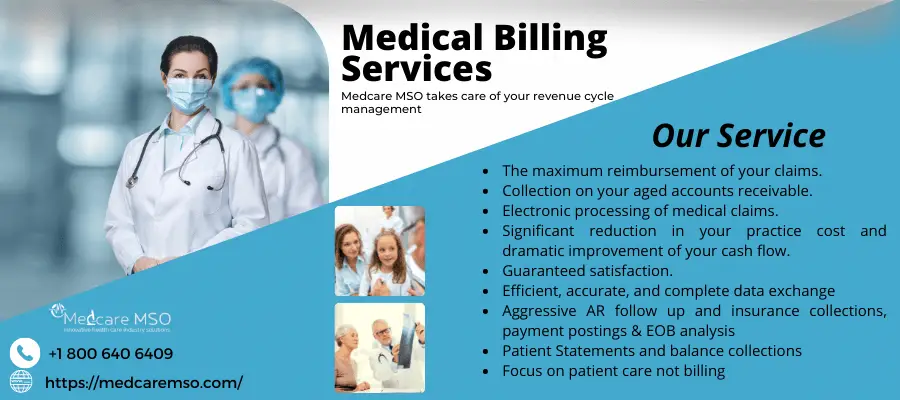Medical practices and other healthcare professionals may find it difficult to manage the technicalities of medical billing. However, providers that frequently monitor their practice’s financial health and ensure that their employees are working at maximum efficiency may enjoy a number of benefits, both operational and financial. Therefore, monitoring the performance indicators for medical billing is one of the key strategies that physicians should use to analyze and pinpoint the strengths and weaknesses of their revenue cycle. Medical billing services can help your business grow and simplify your life.
So, practices should constantly review their revenue cycle management (RCM) activities in order to receive the maximum reimbursement and recover overdue payments. As a top medical billing firm with more than a decade of expertise, Medcare MSO medical billing services has focused on the best ways of discovering and measuring KPIs over time.
Top 5 KPIs and important tips for improving medical billing performance
Consider these best practices for an efficient RCM approach to get the best cash flow and guarantee practice profitability. These key performance indicators (KPIs) for the revenue cycle can help providers decide where to put their resources; what success factors are most important, and what operational decisions to make next.
- Percentage of Net Collection
- Rate of Clean Claim
- Days in Accounts Receivable
- Point-of-Sale Service (POS) Cash Collections
- Total Discharged Days Not Billed
- Resolve Rate
Here is a detailed explanation of these KPIs.
 Percentage of Net Collection
Percentage of Net Collection
The amount of “collectible” dollars obtained is used to calculate the net collection percentage. To determine this value:
- Refunds are subtracted from the total revenues.
- Deduct the contractual modifications from the total fees.
- From this point, divide the first number by the second number. Three variables—orders, payments, and adjustments—can cause the net collection percentage to change.
The outcome of the net collection percentage will improve if adjustments rise relative to payments and charges. The percentage of net collection can be found by this formula.
Net collection percentage = Total Payments/(Charges less Contractual Adjustments)
The gross collection rate gives your practice another perspective on collections. Determine your practice’s gross collection rate by calculating total reimbursement received out of the total amount charged.
The gross collection rate is important because it represents the percentage of collections in relation to the number of charges that are submitted to insurance companies. This figure helps you determine whether you’re charging too much or too little for your services.
Account Receivable Days
Your medical billing revenue cycle includes account receivables, or simply AR. As a result, it is crucial to incorporate it into your KPIs for health care. In this case, the rule is simple and clear: the shorter the number, the better it will be for your revenue collection. Your billing cycle’s longer AR days might be due to a number of factors.
Therefore, you should make a list of any potential issues that might hold down your billing cycle in order to reduce your account receivable days. To guarantee that you get paid on time, all you have to do is work on them. To calculate this KPI, take data from the financial statement and divide total A/R by the average daily net patient service revenue. Another method for calculating average daily net patient care revenue is to divide total yearly earnings by 365.
The Effect of the Rejection Rate
The denial rate is a key performance indicator (KPI) for billing that indicates the ratio of payer-rejected or denied claims. Denials can happen for a number of different reasons, such as inaccurate coding, a lack of supporting evidence, or mistakes made during the claim submission procedure.
It is crucial to monitor this KPI and make every effort to lower denials, as a high denial rate might negatively affect a provider’s bottom line. So, you could hire a professional billing company to do your medical billing to lower the number of claims that are denied.
There are several methods for calculating the denial rate KPI. A typical approach is to divide the total number of claims submitted by the total number of denials.
Resolve Rate
This KPI indicates the overall effectiveness of your RCM workflow in terms of eligibility, billing, and coding. Calculate this KPI by dividing the total number of claims paid within a certain time period by the total number of claims during the same period. If your rate is greater, it suggests that your staff and technique are both excellent.
Final Verdict
In conclusion, medical coding and billing KPIs cannot be overlooked. If you really want to boost the revenue of your practice, you must work on these key performance indicators. Therefore, working with a reliable billing partner can provide you with the ultimate solutions for all your medical billing needs. As a top medical billing firm with more than a decade of expertise, Medcare MSO has focused on the best ways of discovering and measuring KPIs over time. Therefore, you may contact us right now or visit our website to see how we help our clients get the maximum revenue for the services they provide to patients. For more information about our services, please get in touch and visit https://medcaremso.com/services/medical-billing-services/.



 Percentage of Net Collection
Percentage of Net Collection